Business Monograph
Efficiencies generate cycle of higher quality, greater patient satisfaction, and enhanced profitability
It’s time to graduate beyond a paperless practice. Simply converting paper charts to electronic charts is handy and ensures better and more complete documentation, but there’s much more that an electronic health record (EHR) can do. Take your practice to a higher level with fully integrated practice software technology. Software technology can make a practice more efficient and profitable, and the higher quality that results from this integrated approach will impact patient satisfaction positively. Best of all, practices that currently use OfficeMate and ExamWRITER have much of this functionality built in – but many aren’t using it yet.
The federal government wants to help by providing incentives for meaningful use of this technology by 2014. So the time to start is right now – and you’ll start benefitting even sooner. These four practitioners show how they have improved patient communications, staff efficiency, the “wow” factor and profitability by integrating technology into their eye care practices. The first step for all of them was to identify and begin using the multiple applications that already exist in OfficeMate and ExamWRITER, the software suite they each use. They have found that by fully utilizing the technology, they gain exam and billing efficiencies by enhancing office procedures and creating a framework for documentation, data gathering, patient communications and even marketing. In short, they are doing more than saving paper.
Meet the Doctors
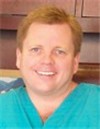 Kim Castleberry, OD, of Plano, Texas. This huge practice has been paperless since 1991, but the technology integration took a big leap forward in 2004, when Dr. Castleberry implemented ExamWRITER. Before that, the 2.5-OD practice employed 23 full-time equivalent employees (FTEs). Today, there are 11.5 FTEs. It’s a 9,000-square-foot office with 15 exam rooms, and about half of the revenues are generated from refractive services and the other half from medical services. There are 60 computer workstations, so, “wherever the patient is – exam room, optical, checking out – the record is there.”
Kim Castleberry, OD, of Plano, Texas. This huge practice has been paperless since 1991, but the technology integration took a big leap forward in 2004, when Dr. Castleberry implemented ExamWRITER. Before that, the 2.5-OD practice employed 23 full-time equivalent employees (FTEs). Today, there are 11.5 FTEs. It’s a 9,000-square-foot office with 15 exam rooms, and about half of the revenues are generated from refractive services and the other half from medical services. There are 60 computer workstations, so, “wherever the patient is – exam room, optical, checking out – the record is there.”
Michael A. Goldsmid, OD, FAAO, of San Diego, Calif.Dr. Goldsmid says OfficeMate and ExamWRITER have brought a level of consistency to the three-OD practice. “Any of us can see each other’s patients without having to scramble to find out what was done or struggle to recognize handwriting,” he says. That’s because “ExamWRITER’s well-thought-out examination sequence, helps our doctors remain consistent and efficient with their data entry, examination findings, impressions, treatment plans, and specialtesting. Our doctors also enjoy the enormous time savings that the automated billing, coding and interpretive reporting provide. [Dr. Goldsmid is shown here in his high-tech office.]
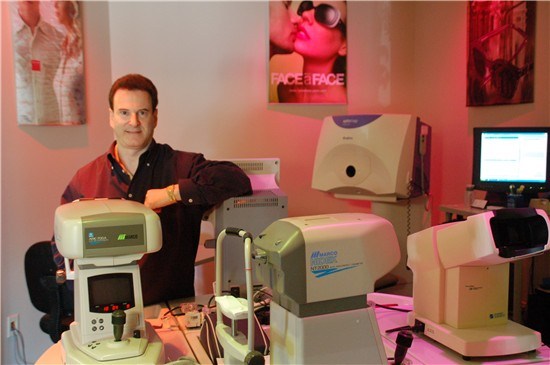
Lorie Lippiatt, OD, of Salem, Ohio. Dr. Lippiatt started using OfficeMate in 1991 and is a member of the development team for OfficeMate and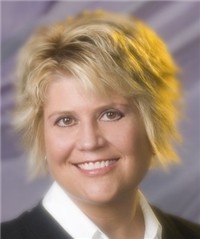 ExamWRITER EMR technology. She began using that around 2002, and the practice became paperless in 2005. One of the benefits of the technology in her office is increase productivity and revenue. Two doctors see 50-60 patients per day now. “I’m seeing almost double the amount of patients in 3.5 days of patient care as I used to be able to accommodate in four full days.”
ExamWRITER EMR technology. She began using that around 2002, and the practice became paperless in 2005. One of the benefits of the technology in her office is increase productivity and revenue. Two doctors see 50-60 patients per day now. “I’m seeing almost double the amount of patients in 3.5 days of patient care as I used to be able to accommodate in four full days.”
Ryan C. Wineinger, OD, of Shawnee Mission, Kan.Dr. Wineinger has been using OfficeMate since the late 1990s and the practice went paperless in 2003, when he implemented ExamWRITER. It’s a two-doctor practice with four exam lanes and five full-time staff. Before OfficeMate, Dr. Wineinger employed eight or nine people. “We’re able to have a smaller staff, and the office flows more smoothly,” he says. “Before, they were spending so much time chasing down records. Now I pay my smaller staff better,” he says, but overall profitability is up.

The Benefits
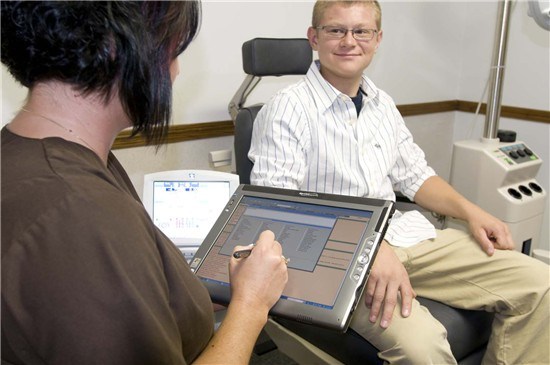 Better Data: Dr. Lippiatt calls OfficeMate and ExamWRITER “the hub of my practice, the epicenter.” Overall efficiencies truly began to accumulate, she says, when she began integrating all her diagnostic instrumentation. “I can access all the results from the anterior seg cameras, Optos technology, digital cameras and refractive data right in the exam room,” she says. That means she has what she needs for a diagnosis and patient education at her fingertips – and the billing office staff have access to the information and documentation they need.
Better Data: Dr. Lippiatt calls OfficeMate and ExamWRITER “the hub of my practice, the epicenter.” Overall efficiencies truly began to accumulate, she says, when she began integrating all her diagnostic instrumentation. “I can access all the results from the anterior seg cameras, Optos technology, digital cameras and refractive data right in the exam room,” she says. That means she has what she needs for a diagnosis and patient education at her fingertips – and the billing office staff have access to the information and documentation they need.
Dr. Goldsmid has had similarly effective results. Patients are escorted into the pretest area, where data from the Marco OPD 3D Wave, Marco Spectrum lensographer, Marco TRS-5100 total refracting system, Humphrey visual field analyzer, Optos technology, pachymeter and wireless motion computing tablets, are integrated into the patient record. During his exam, Dr. Goldsmid adds notations in ExamWRITER, using his portable computing tablet. Icons representing test results appear in the chart, and Dr. Goldsmid can click on these icons to display the most recent test results. These serve as excellent patient education tools, too, he says.
The ROI: Equipment Interface
Value per year: $1,250 plus fewer transcription errors
Average time saved on equipment interface: 2 minutes per patient
2 min. x 50 patients per week x 50 weeks per year = 5,000 minutes
Divided by $15 per hour of staff time
Savings: $1,250 plus the bonus of transcription errors virtually eliminated
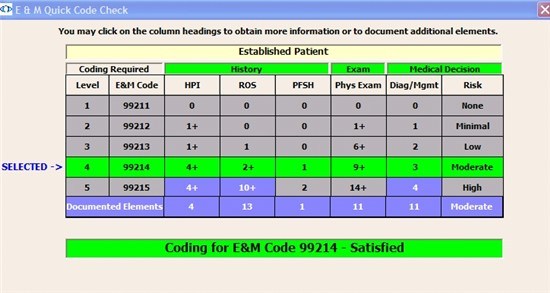 Better Billing: With integrated technology, the diagnosis code, CPT code and modifiers are available to the billing staff immediately. “All you do is assign the insurance, and the claim is done,” says Dr. Castleberry. The software ensures that coding is appropriate and accurate, and that the documentation is available quickly. In fact, Dr. Castleberry says 96 percent of his claims are paid within 14 days. That’s a real boost to cash flow. “It’s deposited automatically. I’m getting paid more and faster than I was before.”
Better Billing: With integrated technology, the diagnosis code, CPT code and modifiers are available to the billing staff immediately. “All you do is assign the insurance, and the claim is done,” says Dr. Castleberry. The software ensures that coding is appropriate and accurate, and that the documentation is available quickly. In fact, Dr. Castleberry says 96 percent of his claims are paid within 14 days. That’s a real boost to cash flow. “It’s deposited automatically. I’m getting paid more and faster than I was before.”
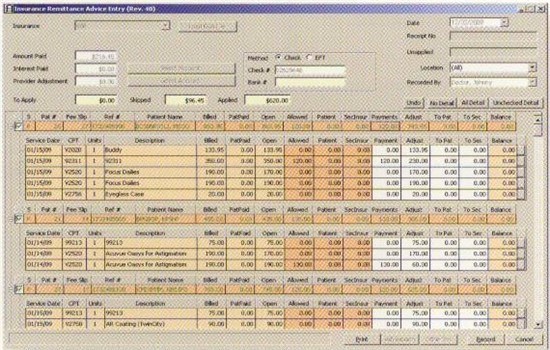 He’s getting paid more because the software guides the practitioner through the billing process so that the maximum appropriate amount is charged.
He’s getting paid more because the software guides the practitioner through the billing process so that the maximum appropriate amount is charged.
So the savings and enhanced revenue mount as the entire process is simplified. Claims per carrier can be batched and sent electronically all at once. Tracking claims is easier. All of these add up to increased efficiency for staff members who formerly had to conduct each of these processes manually or one at a time.
The ROI: Minimized Undercoding
Value per year: $6,250
If one exam per day is undercoded, a conservative estimate is that $25 is left on the table. With a five-day, 50-week year, or 250 days, that’s $6,250.
Improved Patient Communications:
Dr. Wineinger has found that communicating with patients has become speedy and cost-effective. “Confirming appointments via email frees staff from having to make phone calls, and it frees resources because we’re not buying postcards or stamps.” Plus, patients like it. It’s easy to reply to an emailed appointment reminder or to ask for a different time slot. Staff members do still make phone calls, but it’s a more targeted approach. “When we were sending postcards, which cost about 40 cents each with postage, we didn’t know if they were reaching the target. Through WebSystem2 (a patient communication system that integrates with OfficeMate), we can see the bounce rate. So if someone doesn’t get the email, we can try calling that patient.”
Dr. Wineinger can change his recall messages easily and can use that vehicle, as well as the electronic newsletter the practice now emails, to promote products or services. For example, he’s used both formats to explain the benefits of optomap® Retinal Exam technology – and his optomap acceptance rates have risen.
Eyefinity/OfficeMate offers e-Web Extra to design and host a web site. Self-scheduling, prepopulated registration forms and insurance forms are included. The software includes customizable marketing and promotional content, health information content and contact lens reordering functionality.
The ROI: More Effective Recalls
Value per year: $12,500
Assuming a 2 percent higher return:
50 visits per week x 50 weeks a year x $250 per visit x 2%= $12,500
The ROI: Marketing Growth
Value per year: $6,250
Assuming a 1 percent growth in new patients due to improved marketing and tracking
50 patients per week x 50 weeks a year x $250 per visit x 1% = $6,250
Total incremental revenue growth due to improved patient communications: $18,750
Saving Time: When Dr. Wineinger’s practice staff send patients email reminders of their appointment time, they attach the office forms, or welcome forms for new patients. It may seem like a small deal, but those saved minutes keep the office on schedule. “If I have an 11:15 appointment, that patient is in the chair at 11:20,” says Dr. Wineinger. “That increases my efficiency. Instead of scheduling two exams per hour and spending half of that time waiting, I can schedule three or four patients.”
Dr. Lippiatt estimates that her exam efficiency has increased 30 percent.
There are other time-savers built into the OfficeMate and ExamWRITER, such as product-ordering capabilities and automatic data backups at the end of each day with offsite storage. Through a system using bar codes and a scanner, the overall product inventory management becomes simplified. Real-time assessments of inventory mean less assets tied up in inventory that isn’t moving. And OfficeMate provides general practice management information that can drive decisions and corrections as needed based on qualitative data. Doctors can assess regularly what products are selling, patient demographics and important metrics.
Saving Space: Before going paperless, Dr. Lippiatt had a 12’x13’ room where she kept paper files. After the charts were scanned in and the room was empty, she turned it into a special diagnostic testing area. “It’s our technology center where we now have retinal photography, OCT scanning and visual field equipment. It’s gone from not generating any income to being quite a profit center.”
The ROI: Saving Paper
Value per year: $1,250 on existing patients
Don’t forget that paper charts cost money, too – an average of about $2 per patient for a new patient and about $0.50 for a returning patient. With a patient base of 50 returning patients each week, a doctor can achieve a savings of $1,250 – even without calculating what it would have cost to add new paper patient charts.
The ROI: Saving Space
Value per year: $12,000
What’s your rent/cost to operate each square foot of office space? How much of that is dedicated to storage of paper? Using simple numbers as an illustration, let’s say your monthly lease costs are $10 per square foot, and the filing room is about 10’ x 10’. Repurpose that space and that $12,000 per year can move from being non-revenue-generating space to revenue-generating space.Enhanced Per Patient Revenue: When doctors have more time to explain the benefits of new ophthalmic lenses or contact lenses or other treatments – because they’re not spending time looking for results – patients are more likely to purchase the upgraded products. “The right tests are being done so we can make better diagnoses more quickly,” says Dr. Lippiatt. “I can show patients an Eyemaginations loop in the reception area or in the exam room so they understand the concept of what’s available and what will best meet their vision needs.”
E-Prescribing: E-prescribing is one of the necessary components or steps of meaningful implementation. With e-prescribing, prescriptions are sent electronically to the patient’s pharmacy. It’s efficient, reduces errors and saves patients time. It also provides an opportunity for education about why you recommended the specific prescription – and not a generic perhaps – for that patient’s condition. There’s a financial incentive for e-prescribing, as well. Practitioners who file Medicare claims and using e-prescribing are eligible for a 2 percent refund on every Medicare claim.
Improved Follow Up: The software allows these practitioners to generate customized letters to referring practitioners, and it improves communication with patients themselves. For example, letters can be sent to diabetic or glaucoma patients at certain intervals. And the recommended return time for the next visit can be entered by the doctor in the exam room. That way, the preappointment for the next exam is more likely to be completed at checkout – or even in the exam room itself.
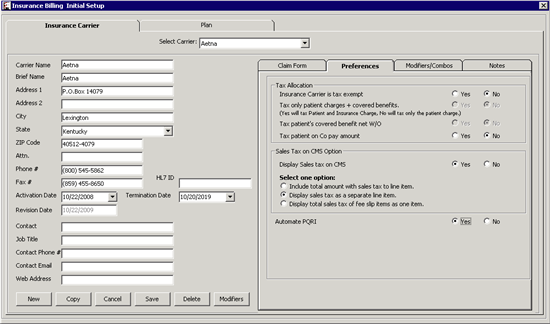 HITECH Act Incentives: To be eligible for up to $44,000 in Medicare payments and up to $65,000 in Medicaid reimbursements, it’s not enough to simply own EHR software. You have to use it in a meaningful way,” says Dr. Castleberry. OfficeMate and ExamWRITER will be fully compliant to allow doctors to meet that standard. With existing functionality and new features, such as autocoding for PQRI, available in version 9, meeting the standard will be easy and automatic within the software. That incentive should be enough to push doctors to action, says Dr. Castleberry, even if it’s not easy.
HITECH Act Incentives: To be eligible for up to $44,000 in Medicare payments and up to $65,000 in Medicaid reimbursements, it’s not enough to simply own EHR software. You have to use it in a meaningful way,” says Dr. Castleberry. OfficeMate and ExamWRITER will be fully compliant to allow doctors to meet that standard. With existing functionality and new features, such as autocoding for PQRI, available in version 9, meeting the standard will be easy and automatic within the software. That incentive should be enough to push doctors to action, says Dr. Castleberry, even if it’s not easy.
“Change is hard. It slows you down for three months, but around the sixth month, you realize the efficiencies and wonder how you ever managed without it.”





















